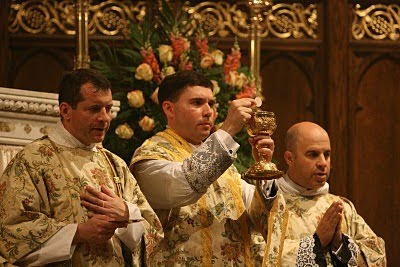In the Office for the Dead throughout the year | |
| Oratio Orémus. Deus, qui inter apostólicos sacerdótes fámulos tuos pontificáli seu sacerdotáli fecísti dignitáte vigére : præsta, quæsumus ; ut eórum quoque perpétuo aggregéntur consórtio. | Collect Let us pray. O God, who didst cause thy servants, for whom we pray, to enjoy the dignity of the priesthood, and some to be bishops, after the order of thine Apostles : grant unto them, we beseech thee, finally to rejoice in the company of those Saints in heaven whose ministry they did sometime share on earth. |
| Deus, véniæ largítor et humánæ salútis amátor : quæsumus cleméntiam tuam ; ut nostræ congregatiónis fratres, propínquos et benefactóres, qui ex hoc sæculo transiérunt, beáta María semper Vírgine intercedénte cum ómnibus Sanctis tuis, ad perpétuæ beatitúdinis consórtium perveníre concédas. | O God, who desirest not the death of a sinner but rather that all mankind should be saved : we beseech thee mercifully to grant that the brethren, kinsfolk, and benefactors of our congregation, who have passed out of this world, may by the intercession of blessed Mary Ever-Virgin and of all thy Saints come to enjoy with them everlasting blessedness. |
| Fidélium, Deus, ómnium cónditor et redémptor, animábus famulórum famularúmque tuárum remissiónem cunctórum tríbue peccatórum : ut indulgéntiam, quam semper optavérunt, piis supplicatiónibus consequántur : Qui vivis et regnas cum Deo Patre in unitáte Spíritus Sancti Deus, per ómnia sæcula sæculórum. R. Amen. | O God, the Creator and Redeemer of all them that believe : grant unto the souls of thy servants and handmaidens the remission of all their sins ; that as they have ever desired thy merciful pardon, so by the supplications of their brethren they may receive the same. Who livest and reignest with the Father, in the unity of the Holy Ghost, ever one God, world without end. R. Amen. |
Double (1955 Calendar): August 28
At Hippo in Africa, the birthday of St. Augustine, bishop and famous doctor of the Church. Converted and baptized by the blessed bishop Ambrose, he defended the Catholic faith with the greatest zeal against the Manicheans and other heretics, and after having sustained many other labours for the Church of God, he went to his reward in heaven. His relics, owing to the invasion of barbarians, were first brought from his own city into Sardinia, and afterwards taken by Luitprand, king of the Lombards, to Pavia, where they were deposited with due honours.
Traditional Matins Reading:
Augustine was born at Tagaste in Africa of noble parents. As a child he was so apt in learning that in a short time he far surpassed in know ledge all those of his own age. When he was a young man he went to Carthage where he fell into the Manichæan heresy. Later on, he journeyed to Rome, and was sent thence to Milan to teach rhetoric. Having frequently listened to the teaching of Ambrose the bishop, he was through his influence inflamed with a desire of the Catholic faith and was baptized by him at the age of thirty-three. On his return to Africa, as his holy life was in keeping with his religion, Valerius the bishop, who was then renowned for his sanctity, ordained him priest. It was at this time that he founded a religious community with whom he lived, sharing their food, and dress, and training them with the utmost care in the rules of apostolic life and teaching. The Manichæan heresy was then growing very strong: he opposed it with great vigour and refuted one of its leaders named Fortunatus.
Valerius perceiving Augustine’s great piety made him his coadjutor in the bishopric. He was always most humble and most temperate. His clothing and his bed were of the simplest kind: he kept a frugal table, which was always seasoned by reading or holy conversation. Such was his loving kindness to the poor, that when he had no other resource, he broke up the sacred vessels, for their relief. He avoided all intercourse and conversation with women, even with his sister and his niece, for he used to say that though such near relatives could not give rise to any suspicion, yet might the women who came to visit them. Never, except when seriously ill, did he omit preaching the word of God. He pursued heretics unremittingly both in public disputations and in his writings, never allowing them to take foothold anywhere; and by these means he almost entirely freed Africa from the Manichees, Donatists and other heretics.
His numerous works are full of piety, deep wisdom and eloquence, and throw the greatest light on Christian doctrine, so that he is the great master and guide of all those who later on reduced theological teaching to method. 'While the Vandals were devastating Africa, and Hippo had been besieged by them for three months, Augustine was seized with a fever. When he perceived that his death was at hand, he had the penitential psalms of David placed before him, and used to read them with an abundance of tears. He was accustomed to say that no one, even though not conscious to himself of any sin, ought to be presumptuous enough to die without repentance. He was in full posses sion of his faculties and intent on prayer to the end. After exhorting his brethren who were around him, to charity, piety and the practice of every virtue, he passed to heaven, having lived seventy-six years, and thirty-six as bishop. His body was first of all taken to Sardinia, afterwards Luitprand, king of the Lombards, translated it to Pavia, where it was honourably entombed.
My Lord God, even now resignedly and willingly, I accept at Thy hand, with all its anxieties, pains, and sufferings, whatever kind of death it shall please Thee to be mine.
By a decree of the Congregation of Indulgences of 9 March 1904, His Holiness Pope Pius X, has granted a plenary indulgence at the moment of death to all the faithful who, on any day they may choose, will receive the sacraments of Penance and Holy Eucharist and make this act for the love of God
A video that is accurate for the most part although please note that some parts (e.g. the usage of the term "Extraordinary Ministers of the Eucharist") are inaccurate.
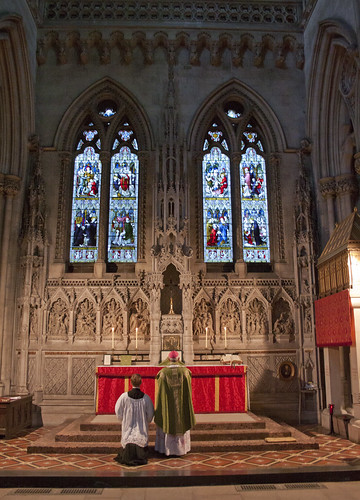
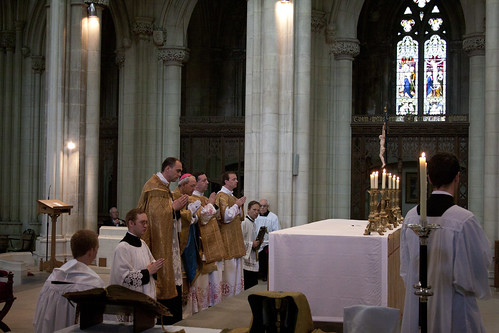

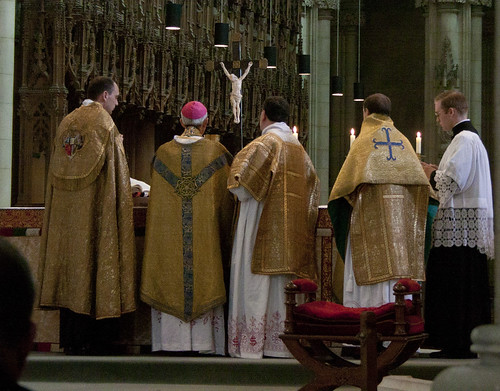
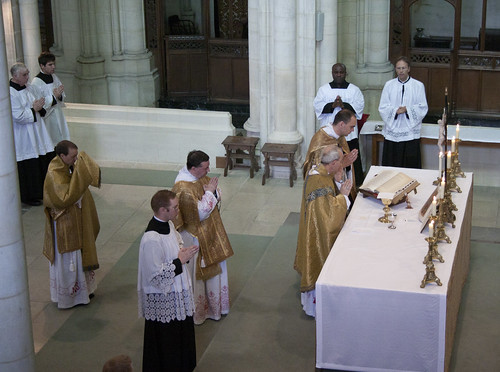
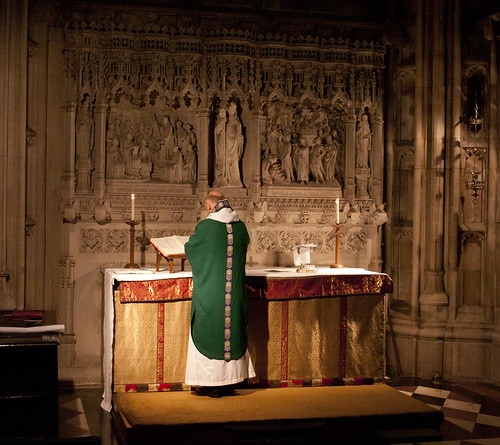
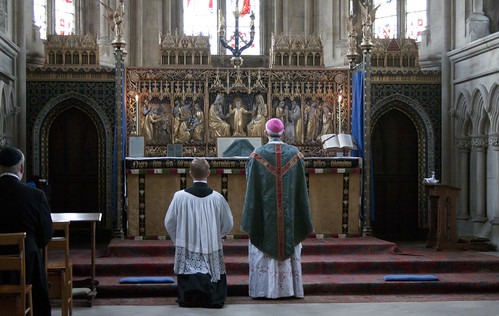

In the Office for the Dead throughout the year | |
| Oratio Orémus. Deus, qui inter apostólicos sacerdótes fámulos tuos pontificáli seu sacerdotáli fecísti dignitáte vigére : præsta, quæsumus ; ut eórum quoque perpétuo aggregéntur consórtio. | Collect Let us pray. O God, who didst cause thy servants, for whom we pray, to enjoy the dignity of the priesthood, and some to be bishops, after the order of thine Apostles : grant unto them, we beseech thee, finally to rejoice in the company of those Saints in heaven whose ministry they did sometime share on earth. |
| Deus, véniæ largítor et humánæ salútis amátor : quæsumus cleméntiam tuam ; ut nostræ congregatiónis fratres, propínquos et benefactóres, qui ex hoc sæculo transiérunt, beáta María semper Vírgine intercedénte cum ómnibus Sanctis tuis, ad perpétuæ beatitúdinis consórtium perveníre concédas. | O God, who desirest not the death of a sinner but rather that all mankind should be saved : we beseech thee mercifully to grant that the brethren, kinsfolk, and benefactors of our congregation, who have passed out of this world, may by the intercession of blessed Mary Ever-Virgin and of all thy Saints come to enjoy with them everlasting blessedness. |
| Fidélium, Deus, ómnium cónditor et redémptor, animábus famulórum famularúmque tuárum remissiónem cunctórum tríbue peccatórum : ut indulgéntiam, quam semper optavérunt, piis supplicatiónibus consequántur : Qui vivis et regnas cum Deo Patre in unitáte Spíritus Sancti Deus, per ómnia sæcula sæculórum. R. Amen. | O God, the Creator and Redeemer of all them that believe : grant unto the souls of thy servants and handmaidens the remission of all their sins ; that as they have ever desired thy merciful pardon, so by the supplications of their brethren they may receive the same. Who livest and reignest with the Father, in the unity of the Holy Ghost, ever one God, world without end. R. Amen. |
To explain this devotion we quote from texts in the public domain as follows.
The rose is blessed on the fourth Sunday of Lent, Lætare Sunday (hence also known as Rose Sunday), when rose-coloured vestments and draperies are substituted for the penitential purple, symbolizing hope and joy in the midst of Lenten solemnity. Throughout most of Lent, Catholics pray, fast, perform penance, and meditate upon the malice of sin and the terrible punishment it brings; Rose Sunday is an opportunity to look beyond Christ's death at Calvary and see Christ, the redeemer, risen in the first rays of the Easter sun, and rejoice. The shining golden flower shows forth Christ's majesty, appropriate because prophets called him "the flower of the field and the lily of the valleys."[1] Its fragrance, according to Pope Leo XIII "shows the sweet odor of Christ which should be widely diffused by His faithful followers" (Acta, vol. VI, 104), and the thorns and red tint refer to His Passion. See Isaiah 63:2: "Why then is thy apparel red, and thy garments like theirs that tread in the winepress?"
The earliest roses were not blessed; instead, blessing was introduced to render the ceremony more solemn and induce greater reverence for it on the part of the recipient. According to Cardinal Petra (Comment. in Constit. Apostolicas, III, 2, col. 1), Pope Innocent IV (1245–54) was the first to bless it. However, others claim that Pope Innocent III (1198–1216), Pope Alexander III (1159–81) or Pope Leo IX (1049–55) was the first. It is said that Leo IX, in 1051, obliged the monastery (nuns) of Bamberg in Franconia, to furnish a Golden Rose to be blessed and carried on Lætare Sunday each year (Theop. Raynaud, De rosa mediana a pontifice consecrata, IV, 413). Pope Benedict XIV attests that the ceremony of blessing originated at the end of the 14th or the beginning of the 15th century. Catalanus, papal master of ceremonies, believes that even the earliest roses were anointed with musk and balsam, but the blessing with prayers, incense, and holy water had its inception later on, sometime before pontificate of Pope Julius II (1503–13). Currently, the pope blesses the rose every year, but it is not always a new and different rose; the old one is used until it has been given away.
Originally (before the papacy moved to Avignon) the rose was blessed in the Hall of Vestments (sacristy) in the palace where the pope was; but the solemn Mass and the donation of the rose took place in the Santa Croce in Gerusalemme (a figure, according to Pope Innocent III, of the heavenly Jerusalem). The blessing was followed by a solemn Mass sung either by the pope himself or the first Cardinal Priest. In the former case the rose was placed on a veil of rose-colored silk richly embroidered with gold; in the latter the pope held the rose in his hand, except while kneeling, or during the Introit, Confiteor, Elevation and the singing of "Laudemus in Domino". Rose in hand, the pope returned processionally to the Lateran Palace; the Prefect of Rome led his horse by the bridle and aided him in dismounting. Upon arrival, he gave the rose to the Prefect, as a recompense for these acts of respect and homage. Prior to 1305, the rose was given in Rome to no foreigner, except the Emperor on the day of his coronation. While residing at Avignon (1305–1375), the popes, unable to visit Roman churches and basilicas, performed many of their sacred functions, among them the blessing of the rose, in the private chapel of their palace (whence the origin of the Cappella Pontificia). On their return to Rome they (Sixtus V excepted) retained this custom.
The blessing of the rose now takes place in the Hall of Vestments (camera dei parimenti), and the solemn Mass in the papal chapel. The rose is placed on a table with lighted candles, and the pope, vested in alb and rose-colored stole and cope with precious mitre on his head, begins the ceremony with the usual versicles and the following poetical prayer:
"O God! by Whose word and power all things have been created, by Whose will all things are directed, we humbly beseech Thy Majesty, Who art the joy and gladness of all the faithful, that Thou wouldst deign in Thy fatherly love to bless and sanctify this rose, most delightful in odour and appearance, which we this day carry in sign of spiritual joy, in order that the people consecrated by Thee and delivered from the yoke of Babylonian slavery through the favour of Thine only-begotten Son, Who is the glory and exultation of the people of Israel and of that Jerusalem which is our Heavenly mother, may with sincere hearts show forth their joy. Wherefore, O Lord, on this day, when the Church exults in Thy name and manifests her joy by this sign [the rose], confer upon us through her true and perfect joy and accepting her devotion of today; do Thou remit sin, strengthen faith, increase piety, protect her in Thy mercy, drive away all things adverse to her and make her ways safe and prosperous, so that Thy Church, as the fruit of good works, may unite in giving forth the perfume of the ointment of that flower sprung from the root of Jesse and which is the mystical flower of the field and lily of the valleys, and remain happy without end in eternal glory together with all the saints."The prayer finished, the pope puts incense (handed by the cardinal-deacon) into the censer and incenses the balsam and then the musk, and afterwards puts the balsam and powdered musk into the tiny cup in the heart of the principal rose. He then incenses the rose and sprinkles it with holy water. It is then given to the youngest cleric of the Camera, who carries it in front of the pope to the chapel, where it is placed on the altar at the foot of the cross upon a richly embroidered silk veil, where it remains during the Mass sung by the first cardinal-priest. After the Mass, the rose is carried in procession before the pope to the sacristy, where it is carefully put away in a place set apart for it, until bestowed upon some worthy personage.
Zenit reports on the use of the Papal Golden Rose by Pope Benedict XVI as follows:
The Golden Rose is a papal decoration conferred on prominent Catholic personalities; it has gone through a significant evolution. Initially, kings and dignitaries received it, later it was conferred almost exclusively on queens and, more recently, on Our Lady. The distinction was created by Pope Leo IX in 1049.
In more recent times, after the Second Vatican Council, the papal decoration has become almost exclusively a gift from popes to Our Lady. This was the 11th Golden Rose that the Pontiff has given to Our Lady in the more than five years of his pontificate. The other 10 were given to the Shrine of Jasna Góra in Poland (2006), the Basilica of Aparecida in Brazil (2007), the Mariazell Basilica in Austria (2007), the Basilica of the National Shrine of the Immaculate Conception in Washington, D.C. (2008), Our Lady of Bonaria in Cagliari, Italy (2008), Our Lady of Pompeii, Italy (2008), Our Lady of Europe in Gibraltar (2009), and the "Virgen de la Cabeza" (literally, Virgin of the Head) of the Diocese of Jaen, Spain (2009), the Shrine of Our Lady of Ta' Pinu (2010), and Our Lady of Fatima (2010).
The apostle St. Bartholomew, who preached the Gospel of Christ in India. Passing thence into the Greater Armenia where, after converting many to the faith, he was flayed alive by the barbarians, and having his head cut off by order of King Astyages, he fulfilled his martyrdom. His holy body was first carried to the island of Lipara, then to Benevento, and finally to Rome in the Island of the Tiber, where it is venerated by the pious faithful.
Source: Pre-1960 Martyrology
Read my prior post dedicated to St. Bartholomew for more information and prayers on this holy saint. St. Barholomew, ora pro nobis!
Disclosure of Material Connection: Some of the links on this blog are “affiliate links.” This means if you click on the link and purchase the item, I will receive an affiliate commission. As an Amazon Associate, for instance, I earn a small commission from qualifying purchases made by those who click on the Amazon affiliate links included on this website. I am disclosing this in accordance with the Federal Trade Commission’s 16 CFR, Part 255: “Guides Concerning the Use of Endorsements and Testimonials in Advertising.”
Support A Catholic Life. Your Patronage Helps Keep Us Updated and Online!
Become a Patron! Support Me On Patreon And Get Access to Exclusive Content, Free Catholic Books, Access to Discounts, and Much More!








